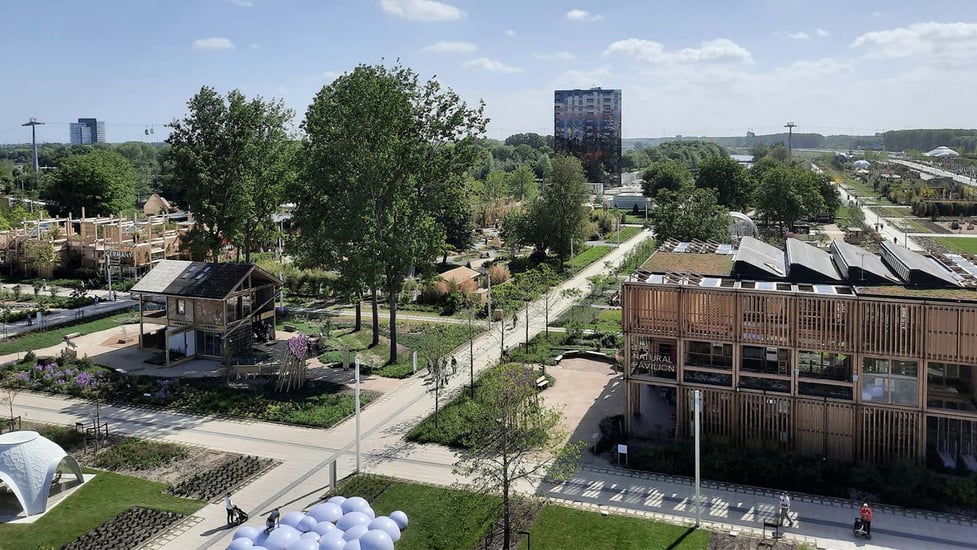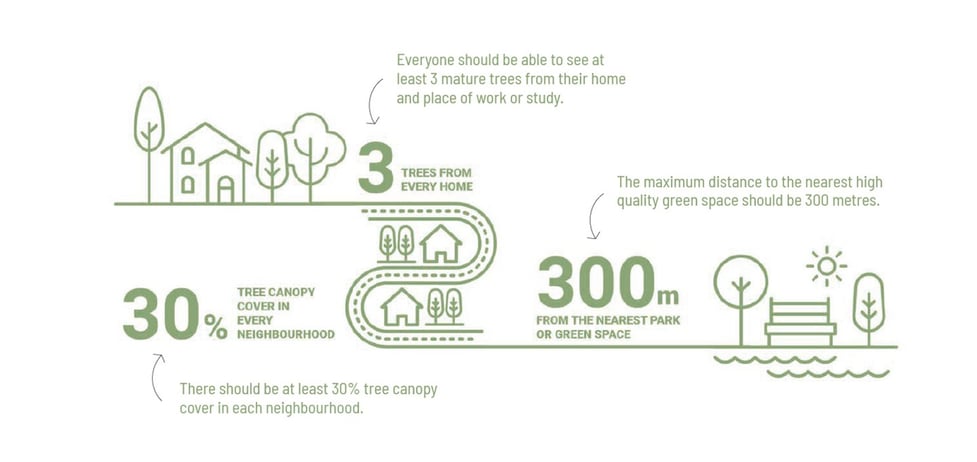Cities are responsible for 70% of all carbon emissions; buildings for 39%, so how we design and manage urban spaces now and in
the future matters. Greening and nature-based solutions – the practice of introducing nature and vegetation into human environments – make
cities healthier, more joyful and equitable. Crucially, in the face of a climate emergency, they also improve sustainability, biodiversity and resilience. When done properly, there are benefits for cities, people, societies and planet and strategies can range from planting a single tree to developing a whole green urban infrastructure.

So how can this be done?
We talk to Cecil Konijnendijk, an urban forester, academic and co-founder/director of the Nature Based Solutions Institute in Malmo, Sweden. His work relates to the role of woodland, trees and other green space in urban settings and societies. In February 2021 Konijnendijk came up with the Threes for Trees or 3:30:300 rule for greening cities. The rule is now being implemented in cities around the world.
3:30:300
In 2021, Cecil launched a new concept for tree provision in urban communities: 3 trees visible from your home; 30% tree canopy cover in your neighborhood; 300 meters to a public park or green space. ‘It’s about how we bring nature to people’s doorsteps,’ he says. ‘The rule is a tri-glomerate: physical nature, surrounding nature and useable nature. If you have 30% canopy cover in your neighborhood you will see multiple benefits in terms of health and also in terms of cooling. During the Covid pandemic we learned the importance of keeping a connection to nature - seeing it from our homes - even if we weren’t able to go out.’ The rule is designed to be easy to remember, straightforward to
implement and monitor and allows urban forests to percolate into working and living environments.
Even in dense cities small spaces will exist where greening can take place, such as a tennis court, courtyard or roof top. Cecil admits that 30% canopy cover ‘can be difficult in some areas but it’s about balance, and technology allows us to do more to bring vegetation into very compact environments.’
Tactical urbanism and the greening of Barcelona
During the COVID-19 pandemic, Barcelona launched the ‘Superblock’ urban planning initiative, where traffic was almost entirely removed from 3x3 urban blocks, and intersections were turned into squares or parks with trees. This type of ‘tactical urbanism’ helps acclimatise people to the possibility of fewer cars and more public space, says Cecil: ‘There was a lot of pushback, especially from shop owners, but improvements such as more space for outdoor cafés meant people stayed around longer and spent more. If people can see the benefits they often change their opinion.’
Avoiding green gentrification
In 2009, the High Line - a disused elevated railway in New York - was transformed into a ‘public landscape’. While celebrated for its innovation, the High Line has also been criticised as an example of green gentrification, with wealthy newcomers pricing out and displacing native New Yorkers. ‘Working with the community is paramount,’ says Cecil, along with the implementation of policies such as ring-fenced affordable housing or controlled rents for social housing. ‘We should still make neighbourhoods greener - but we have to do it very carefully,’ he says.
Looking to the future: the greening of architects
Acceptance is growing for nature-based solutions to the impacts of climate change, particularly among architects, and especially regarding their attitude to trees: ‘The life of a building is usually shorter than that of a tree, so architects must ensure trees stay when a new building is being established. This represents a paradigm shift in architectural thinking - that the living components of a site must be considered, and also integrated into buildings.’
Cecil is therefore is optimistic about the future: ‘Trees and greening are now part and parcel of urban planning strategies,’ he says. ‘When I first introduced the 3:30:300 rule, I was surprised at the level of interest from ‘non-green' people such as politicians, architects, planners and engineers. They considered it something which made sense, and with which they could work. Now support for greening is much bigger than ever before, and that’s very encouraging.’
FACTS About Cecil Konijnendijk  Cecil Konijnendijk is co-founder and director of the Nature Based Solutions Institute in Malmo, Sweden. He is also honorary professor at the Faculty of Forestry at the University of British Columbia, Canada, visiting scholar and chair of Forest and Nature Policy at Wageningen University, The Netherlands, editor-in-chief of the scientific journal Arboriculture & Urban Forestry, and series editor of the Springer Future City book series.
Cecil Konijnendijk is co-founder and director of the Nature Based Solutions Institute in Malmo, Sweden. He is also honorary professor at the Faculty of Forestry at the University of British Columbia, Canada, visiting scholar and chair of Forest and Nature Policy at Wageningen University, The Netherlands, editor-in-chief of the scientific journal Arboriculture & Urban Forestry, and series editor of the Springer Future City book series.